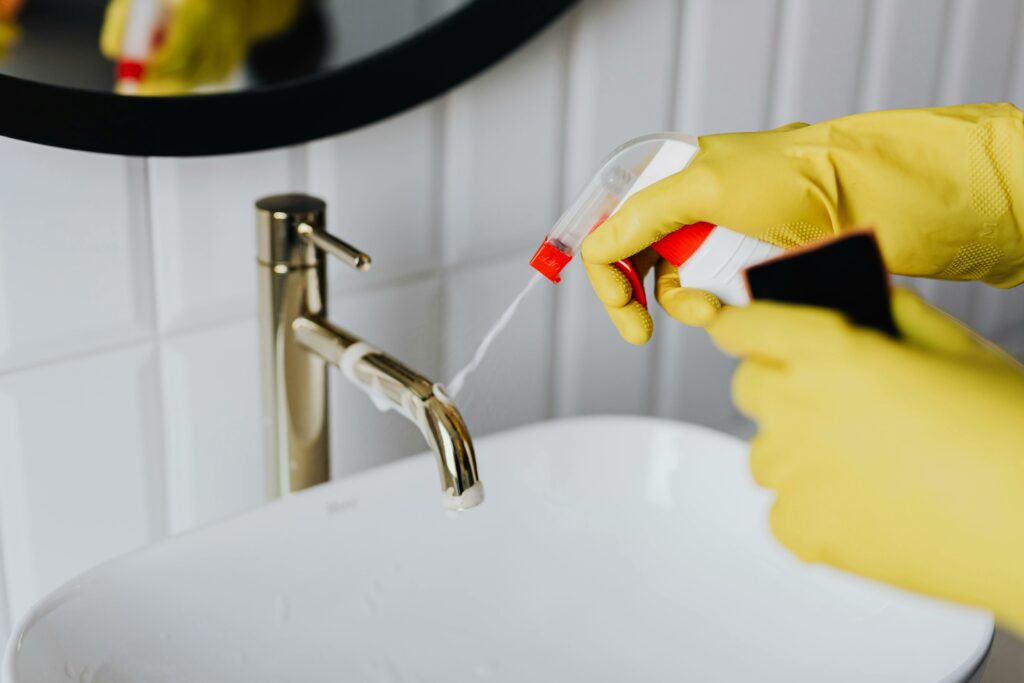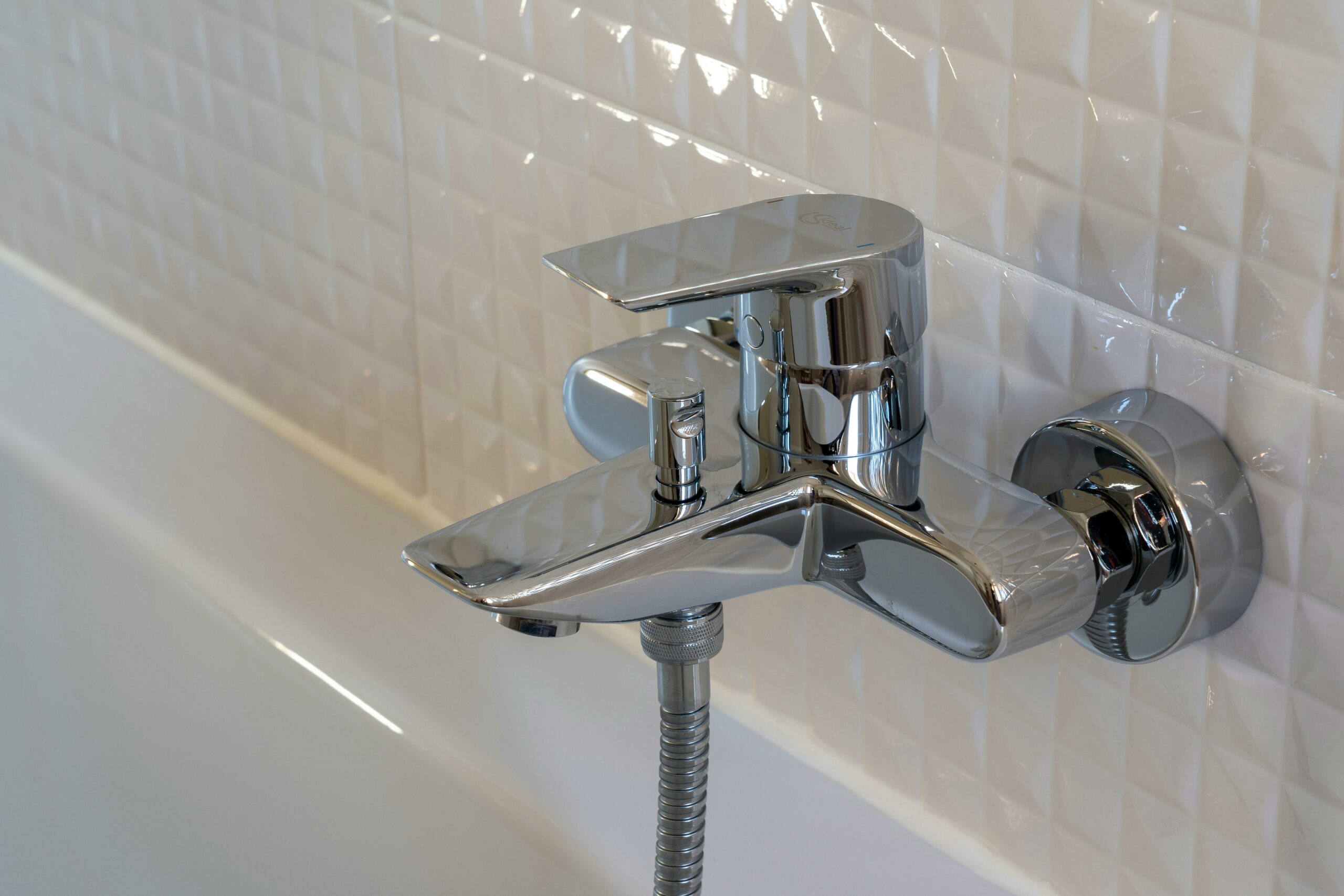Limescale is a common household problem, especially in areas with hard water. It forms on shower walls, faucets, and glass screens, creating a stubborn, chalky residue that can be difficult to remove. Understanding why limescale accumulates and how to combat it effectively will help keep your bathroom fixtures clean and well-maintained. This comprehensive guide will explore the causes of limescale buildup, its effects on different surfaces, and the best strategies to prevent and eliminate it.
Key Takeaways
- Limescale is caused by mineral deposits from hard water.
- It builds up faster in areas with frequent water exposure, such as showers, faucets, and glass screens.
- Limescale can damage fixtures, reduce water flow, and create an unsightly appearance.
- Regular cleaning and preventative measures can minimize limescale buildup.
- Natural and chemical solutions are available to remove limescale effectively.
What Causes Limescale Buildup?
Limescale forms when water evaporates and leaves behind mineral deposits, primarily calcium and magnesium. Hard water contains high levels of these minerals, which accumulate over time on surfaces frequently exposed to water. The most common areas affected by limescale include showers, faucets, and glass screens.
The buildup process is accelerated in places where water dries and evaporates regularly. Hot water also plays a significant role in limescale formation, as heat speeds up the deposition of minerals. Without regular cleaning, these deposits can harden, making them more challenging to remove.
Effects of Limescale on Bathroom Fixtures
Limescale is more than just an aesthetic issue; it can negatively impact the functionality of your bathroom fixtures. Over time, the accumulation of mineral deposits can lead to a variety of problems, from minor inconveniences to significant damage that requires costly repairs or replacements. Addressing limescale buildup promptly can help maintain the efficiency and longevity of your bathroom fixtures.
Some of the main problems caused by limescale buildup include:
- Reduced Water Flow: Limescale can clog showerheads and faucets, leading to lower water pressure. The buildup of mineral deposits restricts the flow of water, causing uneven spray patterns and reducing the overall efficiency of your plumbing system. If left untreated, it can result in complete blockages that require professional intervention.
- Staining and Discoloration: White or yellowish deposits can make glass screens and metal fixtures look unclean. Over time, limescale can create a cloudy film on shower doors, leaving them looking dull and streaked. The buildup can also stain metal faucets and showerheads, diminishing their shine and making them appear old and worn.
- Damage to Fixtures: Over time, limescale can corrode metal components, shortening the lifespan of your bathroom fittings. Mineral deposits can weaken the structure of faucets, showerheads, and pipes, leading to leaks, cracks, and eventual failure. In extreme cases, excessive buildup can cause irreversible damage, requiring costly replacements.
- Increased Cleaning Effort: The longer limescale remains untreated, the harder it is to remove, requiring stronger chemicals and more scrubbing. Hardened deposits bond to surfaces, making them resistant to simple wiping or mild cleaning solutions. Regular maintenance is necessary to prevent stubborn buildup that demands extensive effort and harsh chemical treatments.
Where Does Limescale Accumulate the Most?
Limescale tends to form in areas that experience frequent exposure to water, particularly where water is left to evaporate. The mineral deposits in hard water build up over time, leaving behind chalky, white, or yellowish residues on various surfaces. These deposits not only affect the appearance of bathroom fixtures but can also reduce their efficiency. Understanding the most common areas where limescale accumulates can help homeowners take targeted action to prevent buildup and maintain a cleaner bathroom.
1. Shower Walls and Glass Screens
Showers are exposed to constant water splashes, making them prime areas for limescale buildup. Glass screens, in particular, can quickly develop a cloudy, spotted appearance due to dried mineral deposits. Soap scum can also combine with limescale, creating an even tougher residue.
2. Faucets and Showerheads
Limescale tends to accumulate around faucet spouts and showerheads, where water flow is most concentrated. This buildup can clog small openings, reducing water pressure and affecting the efficiency of your fixtures.
3. Tile and Grout
The minerals in hard water can settle into the grout between tiles, making them appear dull and discolored. Limescale buildup on tiles can also make surfaces feel rough and look less polished.

How to Prevent Limescale Buildup
Preventing limescale buildup is much easier than dealing with heavy deposits once they have formed. By incorporating a few simple habits into your cleaning routine, you can significantly reduce the presence of limescale and maintain the pristine condition of your bathroom fixtures. Hard water is the primary cause of limescale, so taking measures to soften water and minimize mineral deposits will help keep your shower, faucets, and glass screens free of stubborn residue.
Prevention is the best strategy to keep limescale under control. Implementing simple habits and using effective products can significantly reduce buildup and maintain the appearance of your bathroom fixtures.
- Wipe Surfaces Dry After Use: Limescale forms when water evaporates, so drying your shower, faucet, and glass screen after each use prevents mineral deposits from settling. Using a microfiber cloth or a squeegee can help remove excess water efficiently.
- Use a Water Softener: Installing a water softener reduces the mineral content in your water, preventing limescale from forming. Water softeners use ion-exchange technology to replace calcium and magnesium ions with sodium or potassium, significantly lowering the chances of buildup.
- Apply a Protective Coating: Some glass treatments and water-repellent sprays can create a barrier against mineral deposits, making it harder for limescale to stick. Applying these treatments to shower doors and faucets can make future cleaning easier and more effective.
- Regular Maintenance Cleaning: Frequent light cleaning with vinegar or a mild limescale remover prevents heavy buildup. Using a daily shower spray or a diluted vinegar solution can help dissolve mineral deposits before they harden. Monthly deep cleaning with descaling agents will further prevent stubborn accumulations.
Best Methods to Remove Limescale
If limescale has already built up, various methods can effectively remove it. Depending on the severity of the buildup, you can use natural solutions or commercial cleaning products. The key to effective removal is choosing the right method for the surface and ensuring regular maintenance to prevent future buildup. Below are some of the most effective techniques to eliminate limescale and restore your bathroom fixtures to their original shine.
If limescale has already built up, various methods can effectively remove it. Depending on the severity of the buildup, you can use natural solutions or commercial cleaning products.
1. Using Vinegar and Baking Soda
Vinegar is one of the best natural limescale removers. The acidity dissolves mineral deposits without damaging surfaces, while baking soda acts as a gentle abrasive to lift stubborn buildup. This combination is both effective and eco-friendly.
Vinegar is one of the best natural limescale removers. The acidity dissolves mineral deposits without damaging surfaces.
- Soak a cloth in vinegar and wrap it around faucets or showerheads.
- Spray vinegar on glass screens and let it sit for 10-15 minutes before wiping away.
- Mix baking soda with vinegar to create a paste for scrubbing tiles and grout.
2. Lemon Juice for Stubborn Deposits
Lemon juice works similarly to vinegar due to its acidity but provides a fresh scent and additional antibacterial properties. It is particularly effective on glass screens and metal fixtures.
Lemon juice works similarly to vinegar due to its acidity.
- Apply fresh lemon juice to affected areas and let it sit for a few minutes.
- Scrub gently with a sponge or microfiber cloth before rinsing.
3. Commercial Limescale Removers
For more stubborn or long-term buildup, commercial limescale removers provide a powerful solution. These cleaners contain specialized ingredients that break down mineral deposits quickly and efficiently.
If natural solutions don’t fully remove the buildup, specialized limescale removers can provide a stronger solution.
- Choose a cleaner specifically designed for bathroom surfaces to avoid damage.
- Follow the manufacturer’s instructions and ensure proper ventilation when using chemical solutions.
4. Preventative Cleaning Routine
Regular maintenance is essential for keeping limescale at bay. Implementing a routine cleaning schedule with natural or commercial products will ensure your bathroom remains free from buildup.
- Clean glass screens and shower walls weekly with a vinegar-based solution.
- Descale faucets and showerheads monthly by soaking them in vinegar.
- Use a daily shower spray to minimize residue accumulation.
Frequently Asked Questions
1. What is the main cause of limescale in the shower and faucet?
Limescale is primarily caused by hard water, which contains high levels of calcium and magnesium. When water evaporates, it leaves behind mineral deposits that accumulate over time.
2. Can limescale damage my fixtures permanently?
Yes, if left untreated, limescale can corrode metal surfaces, clog showerheads, and reduce water flow. Regular maintenance helps prevent long-term damage.
3. Are natural solutions like vinegar and lemon effective against limescale?
Yes, vinegar and lemon juice are highly effective at breaking down limescale. However, for severe buildup, stronger commercial cleaners may be necessary.
4. How can I prevent limescale from coming back?
Using a water softener, wiping down wet surfaces after use, and regular cleaning with mild acidic solutions can help prevent limescale buildup.
Final Thoughts
Limescale buildup in showers, faucets, and glass screens is a common issue in homes with hard water. Understanding why it forms and how to prevent it can help maintain the cleanliness and longevity of your bathroom fixtures. Regular cleaning with natural or commercial solutions ensures that limescale doesn’t become a stubborn problem. By incorporating simple habits like wiping surfaces dry and using descaling treatments, you can keep your bathroom looking spotless and functioning efficiently year-round.





